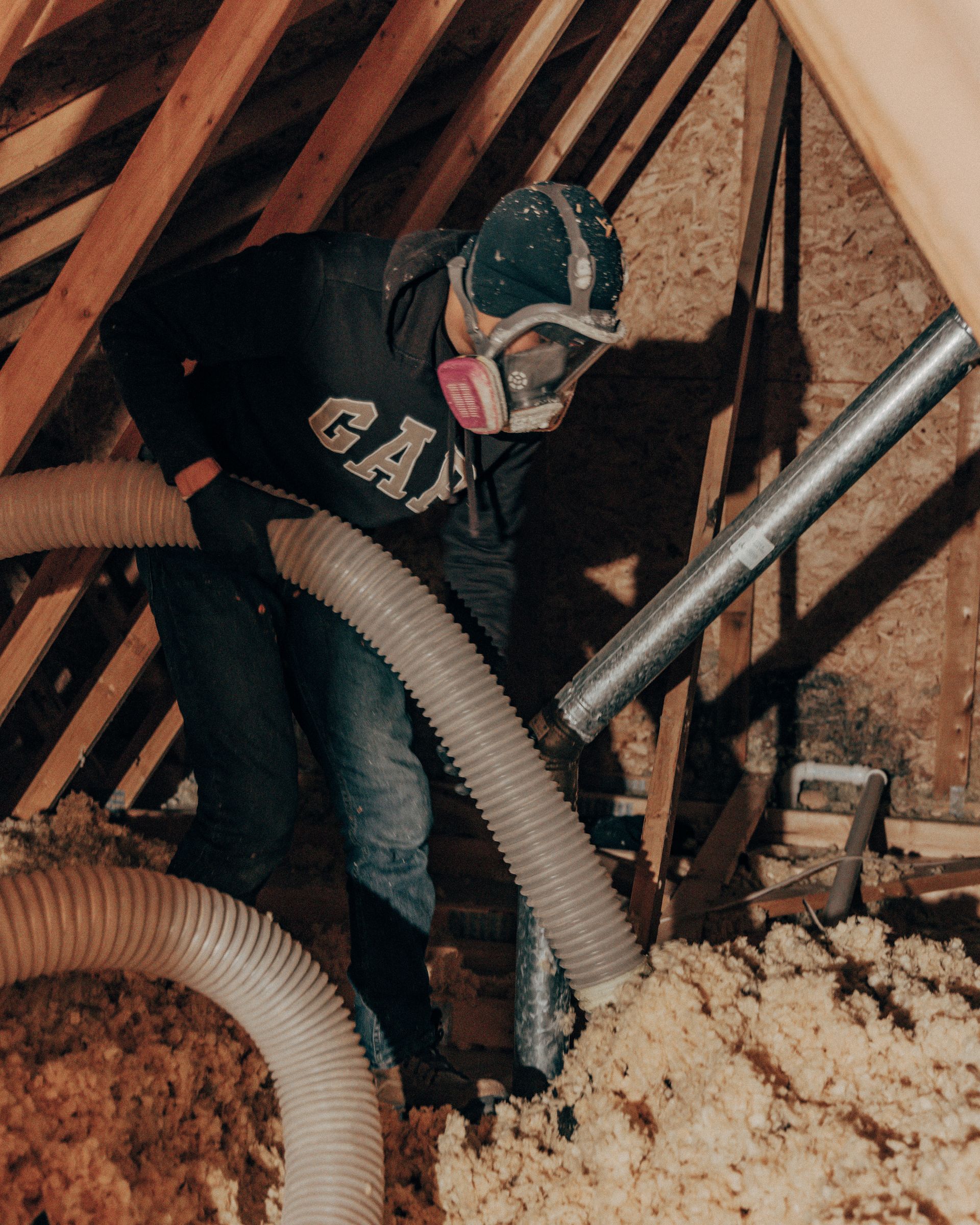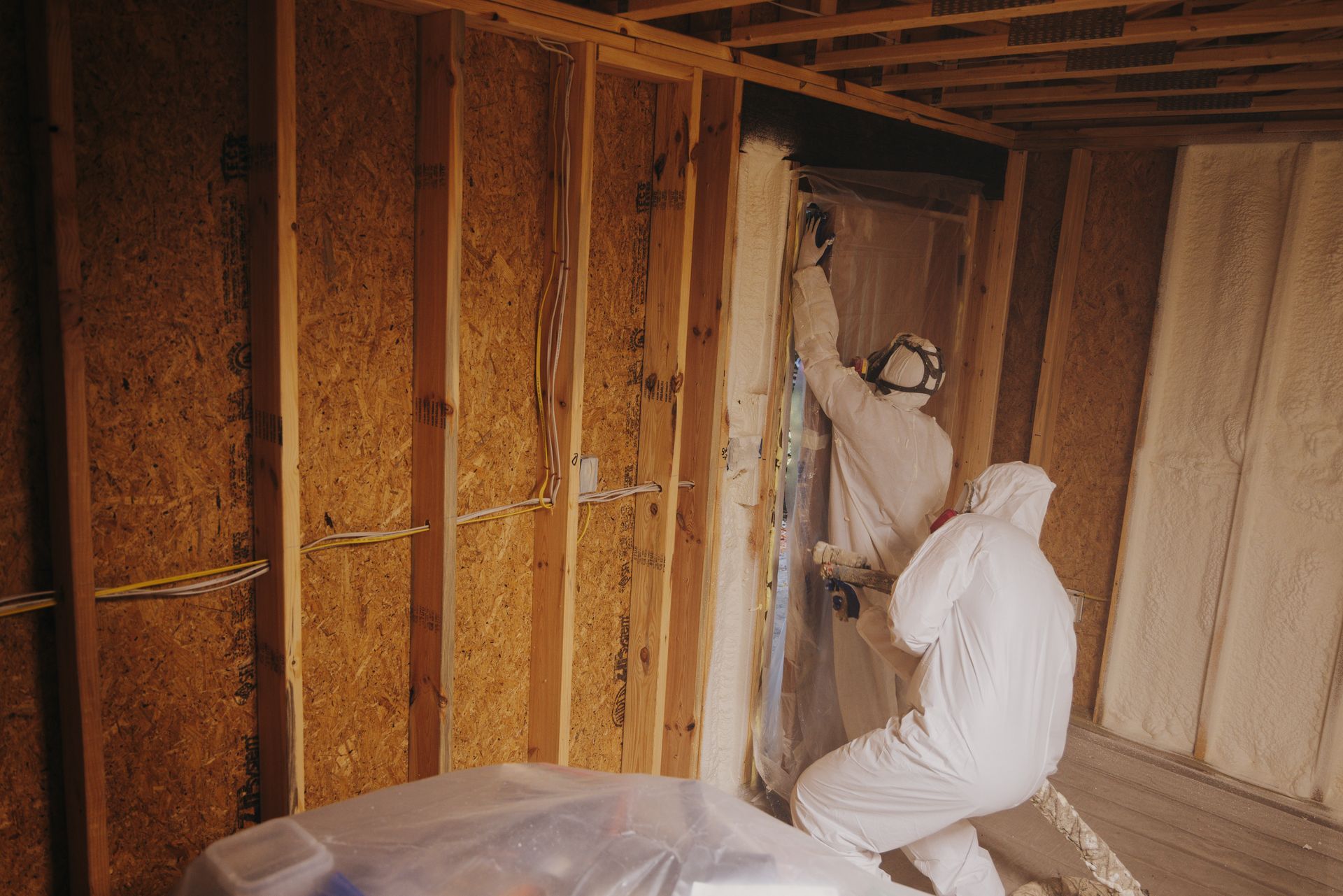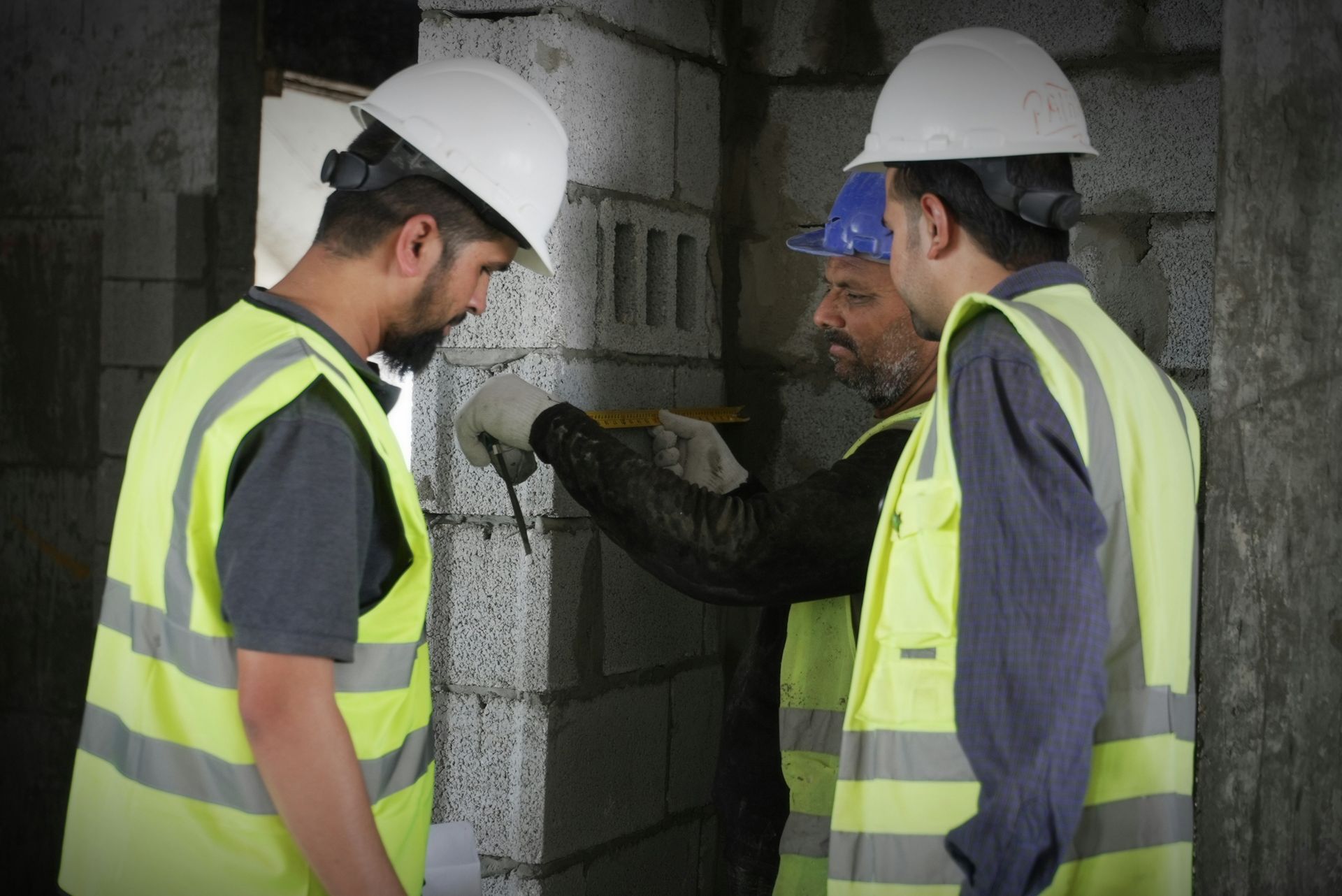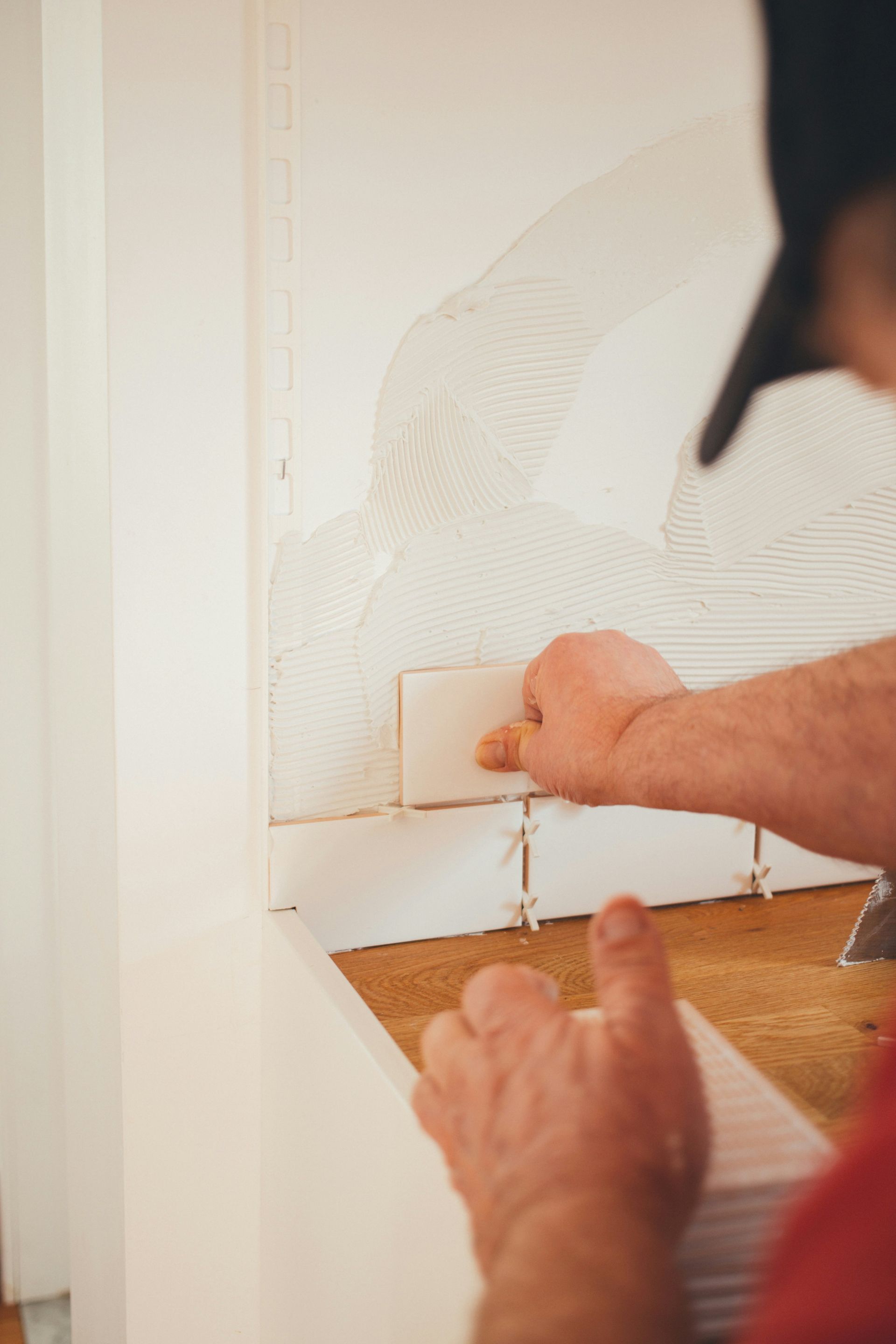Step-by-Step: How to Install Spray Foam Insulation

Installing spray foam insulation offers superior insulation compared to traditional materials like fiberglass. This foam expands to fill gaps and cracks, creating an airtight seal on walls, floors, and ceilings. Proper installation requires careful preparation, safety precautions, and the right equipment to apply the coating effectively.
In this article, we’ll explain the step-by-step process of installing spray foam insulation, from preparation to cleanup.
Key Takeaways
- Proper preparation is essential for successful spray foam insulation installation
- Open-cell and closed-cell foam have different properties suited for various applications
- Safety measures and protective gear are crucial during spray foam installation.
- Precise application techniques ensure even coverage and optimal insulation performance
- Post-installation steps include inspection, trimming, cleanup, and assessing additional insulation needs
Preparing the Area for Spray Foam Insulation

Before spray insulation installers begin their work, thorough preparation is essential. This process involves clearing the area, protecting surfaces, addressing existing issues, and ensuring proper ventilation. These steps help prevent moisture problems, minimize overspray damage, and contribute to the overall cost-effectiveness of the project. An energy audit may be conducted to identify areas requiring special attention. Proper preparation also helps protect drywall and other surfaces from potential damage during installation.
Clearing the Workspace of Debris and Obstacles
Clearing the workspace of debris and obstacles marks the first crucial step in preparing for spray foam insulation installation. Blow insulation contractors meticulously remove all items from the area, including furniture, stored belongings, and construction materials. This process extends to every nook and cranny, from the attic to the basement, ensuring a clean slate for the insulation application. Proper cleaning facilitates efficient installation and prevents potential contamination of the spray foam, which is essential for optimal building insulation performance and basement waterproofing.
Covering Windows, Doors, and Floors to Protect From Overspray
Protecting surfaces from overspray is a critical step in spray foam insulation installation. Foam insulation installers at Mammoth carefully cover windows, doors, and floors with plastic sheeting or drop cloths to prevent damage and ensure a clean finish. This protective measure safeguards the home’s interior, preserving the aesthetic appeal and structural integrity of the attic and other areas. Proper coverage also contributes to a safer work environment, reducing potential health risks associated with overspray exposure during the home improvement project.
- Remove all items from the workspace
- Conduct an energy audit
- Clear debris and obstacles
- Cover windows, doors, and floors
- Ensure proper ventilation
- Address existing issues
Checking for and Sealing Any Existing Gaps or Cracks
Before applying spray foam insulation, we thoroughly inspect the area for gaps and cracks. Technicians at Mammoth seal these openings in walls, ceilings, and concrete surfaces to enhance thermal insulation effectiveness and improve indoor air quality. This crucial step prevents air leakage and moisture intrusion, ensuring optimal performance of the insulation system.
Ensuring Adequate Ventilation for the Area
Mammoth prioritizes adequate ventilation during foam installation to protect the health of workers and occupants. This crucial step prevents the buildup of harmful fumes and ensures proper curing of the foam, maximizing the investment in waterproofing and insulation. Unlike cellulose insulation, spray foam requires careful management of air circulation to achieve optimal results and maintain a safe working environment.
Understanding the Types of Spray Foam Insulation

Spray foam insulation comes in two main types: open-cell and closed-cell. Each type has unique properties that affect its performance, cost, and suitability for different applications. Understanding these differences is crucial for selecting the right foam for a project and calculating the required amount. Factors such as accessibility, chemical reaction, and the need for proper ventilation and respirator use during installation play significant roles in the decision-making process. Even considerations like lawn protection may influence the choice between open-cell and closed-cell foam, as overspray can potentially damage surrounding vegetation.
Differences Between Open-Cell and Closed-Cell Foam
Open-cell and closed-cell spray foam insulation differ in density, insulation value, and moisture permeability. Open-cell foam expands more, filling gaps effectively in crawl spaces and attics, but offers less insulation per inch. Closed-cell foam provides superior insulation and acts as a vapor barrier, making it ideal for moisture-prone areas. Blow insulation companies often recommend closed-cell foam for renovation projects where mold prevention is crucial. The choice between these types depends on the specific requirements of the space and the desired outcome of the insulation project:
| Property | Open-Cell Foam | Closed-Cell Foam |
|---|---|---|
| Density | Lower (0.5-0.8 lb/ft³) | Higher (1.7-2.2 lb/ft³) |
| R-Value per inch | 3.6-3.8 | 6.0-7.0 |
| Moisture permeability | Higher | Lower |
| Air barrier | Yes | Yes |
| Vapor barrier | No | Yes |
Deciding Which Type of Spray Foam Is Right for Your Project
Selecting the appropriate spray foam insulation type depends on various factors, including the project’s specific requirements, budget constraints, and environmental conditions. Closed-cell foam offers superior soundproofing and moisture resistance, making it ideal for roof applications and areas at risk of water damage. While less expensive, open-cell foam provides excellent air-sealing properties and is often preferred for interior walls in new construction. Homeowners should carefully weigh the initial cost against long-term energy savings to determine which type offers the best value for their money.
Calculating the Amount of Spray Foam Needed
Installing spray foam insulation demands precise calculations to create an effective air barrier. Mammoth professionals use specialized software or formulas to estimate the required amount, taking into account the foam’s expansion properties and the need for personal protective equipment. Proper calculation helps minimize material waste and ensures adequate coverage for optimal insulation performance. The calculation process involves:
- Measuring the total surface area to be insulated
- Determining the required depth of foam application
- Considering the foam’s expansion rate
- Adjusting for potential waste and overspray
- Factoring in the specific foam type’s yield per set
Safety Measures When Installing Spray Foam Insulation

Installing spray foam insulation requires stringent safety measures to protect both installers and occupants. Spray insulation companies prioritize these precautions to prevent potential health risks and ensure a successful application. Proper protective gear, adequate ventilation, and knowledge of chemical handling are essential to mitigate hazards associated with the installation process. Although there are common concerns regarding spray foam insulation, the reality is that as long as individuals are not in the immediate area where spray foam is being applied, they should be safe.
These safety protocols not only safeguard against immediate dangers but also contribute to the insulation’s long-term effectiveness in preventing water damage, deterring pests, and reducing heat transfer. By adhering to these safety guidelines, professionals create a secure environment for the installation while maximizing the benefits of spray foam insulation in the treated space.
Choosing the Right Protective Gear
Foam insulation installers must select appropriate protective gear to safeguard against potential hazards associated with spray foam application. This equipment includes full-body coveralls, respirators with organic vapor cartridges, safety goggles, and chemical-resistant gloves. Proper gear protects against skin contact with the foam mixture, inhalation of fumes, and exposure to harmful odors and humidity during the installation process:
| Protective Item | Purpose |
|---|---|
| Full-body coveralls | Prevent skin contact with foam |
| Respirator | Filter out harmful vapors |
| Safety googles | Protect eyes from spray |
| Chemical-resistant gloves | Guard hands against chemicals |
Ventilating the Area Properly During and After Installation
Proper ventilation is crucial during and after spray foam insulation installation. Contractors at Mammoth use powerful exhaust fans to maintain air circulation, remove fumes, and ensure a safe work environment. After application, insulation foam contractors continue ventilation for at least 24 hours, allowing the foam to cure fully and preventing the buildup of off-gassing vapors that could potentially compromise the wall structure or wood elements. This process also helps maintain the integrity of the vapor barrier created by the insulation.
Knowing How to Handle Chemical Spills or Exposure
Spray foam installers must be prepared to handle chemical spills or exposure during insulation. This includes readily available safety equipment near work areas, such as eyewash stations and chemical spill kits. In case of a spill, workers should immediately contain the chemical substance, prevent it from spreading to water sources or window areas, and follow proper cleanup procedures. If exposure occurs, especially around joists or other confined spaces, individuals should quickly remove contaminated clothing, rinse the affected area with water, and seek medical attention if necessary.
| Situation | Action |
|---|---|
| Chemical Spill | Contain, prevent spread, clean up |
| Skin Exposure | Remove clothing, rinse with water |
| Eye Contact | Flush with eyewash station |
| Inhalation | Move to fresh air, seek medical help |
How to Apply Spray Foam Insulation Effectively

Applying spray foam insulation effectively requires a combination of technical skills, proper equipment handling, and environmental awareness. The process involves careful preparation of the spray foam gun and materials, mastering techniques for even application, and monitoring temperature and humidity for optimal curing.
Preparing the Spray Foam Gun and Materials
Preparing the spray foam gun and materials is a critical step in the installation process. Technicians carefully clean and inspect the gun, ensuring all components are in working order. They then mix the foam chemicals according to manufacturer specifications, considering factors like plumbing obstacles that may affect the application. This preparation phase also involves checking the temperature of the materials and adjusting the spray settings for optimal performance:
| Step | Action |
|---|---|
| 1 | Clean and inspect spray gun |
| 2 | Mix foam chemicals |
| 3 | Check material temperature |
| 4 | Adjust spray settings |
Techniques for Even Application
Achieving even the application of spray foam insulation requires precise technique and control. Installers maintain a consistent distance from the surface, typically 18-24 inches, while moving the spray gun in a smooth, overlapping pattern. They adjust the spray speed and angle based on the surface contours and desired thickness, ensuring uniform coverage and proper adhesion to studs, joists, and other structural elements.
Monitoring Temperature and Humidity for Optimal Curing
Monitoring temperature and humidity is crucial for optimal curing of spray foam insulation. Installers use specialized equipment to track these environmental factors throughout the application process, ensuring the foam sets properly. They adjust application techniques and timing based on these readings to achieve the best results:
| Factor | Ideal Range | Impact on Curing |
|---|---|---|
| Temperature | 70-80°F (21-27°C) | Affects foam expansion and adhesion |
| 2 | 30-60% | Influences drying time and final texture |
| 3 | Above 50°F (10°C) | Ensures proper bonding to surfaces |
Applying Foam in Difficult-to-Reach Areas
Applying spray foam insulation in difficult-to-reach areas requires specialized techniques and tools. Installers use extension wands and angled nozzles to access tight spaces, such as corners, crawl spaces, and areas around plumbing or electrical fixtures. They may also employ flexible hoses or remote spraying systems to ensure complete coverage in challenging locations, maintaining consistent application quality throughout the insulation process.
Ensuring Even Coverage and Thickness
Ensuring even coverage and thickness remains crucial for optimal spray foam insulation performance. Installers carefully monitor the application process, using depth gauges and visual inspections to maintain consistent foam thickness across all surfaces. They pay special attention to corners, joints, and transitions between different materials, often applying multiple thin layers rather than a single thick coat to achieve uniform coverage and prevent gaps or voids in the insulation barrier.
Troubleshooting Common Spray Foam Installation Issues
Spray foam insulation installation may encounter various challenges that require prompt attention and effective solutions. Installers must be prepared to address issues such as overspray, uneven application, and curing problems to ensure the insulation’s optimal performance. By understanding common troubleshooting techniques, professionals at Mammoth can quickly resolve these issues, maintaining the integrity of the insulation system and maximizing its energy-saving benefits. Proper handling of these challenges improves the installation’s quality and enhances the spray foam’s overall effectiveness in providing thermal insulation and air-sealing properties.

Dealing With Overspray and Unwanted Foam
Dealing with overspray and unwanted foam requires quick action and proper cleanup techniques. Installers use specialized solvents to remove excess foam from surfaces before fully curing, carefully scraping away any hardened material without damaging the underlying structure. For difficult-to-remove overspray, professionals may employ heat guns or mechanical abrasion methods, followed by thorough cleaning to restore the affected areas to their original condition.
Fixing Gaps and Uneven Application
Fixing gaps and uneven application in spray foam insulation requires careful attention and precise techniques. Installers identify problem areas through visual inspection and thermal imaging, then apply additional foam to fill gaps or level out uneven spots. For larger inconsistencies, they may need to remove and reapply sections of foam to ensure uniform coverage and optimal insulation performance:
- Inspect the insulated area for gaps and unevenness
- Use thermal imaging to detect inconsistencies
- Apply additional foam to fill gaps
- Level out uneven spots with precise application
- Remove and reapply foam for larger problem areas
Addressing Curing Problems or Chemical Reactions
Addressing curing problems or chemical reactions in spray foam insulation requires immediate attention and expertise. Installers carefully monitor the foam’s consistency, color, and texture during application, identifying any signs of improper mixing or off-ratio spraying. If issues arise, they quickly adjust the spray equipment settings or replace faulty components to ensure proper chemical reactions and curing. In cases of severe curing problems, professionals may need to remove the affected areas and reapply the foam to maintain the insulation’s integrity and performance.
- Monitor foam consistency, color, and texture
- Identify signs of improper mixing or off-ratio spraying
- Adjust spray equipment settings
- Replace faulty components if necessary
- Remove and reapply foam in severe cases
Post-Application Steps and Cleanup
After applying spray foam insulation, installers must complete several crucial post-application steps to ensure the project’s success. These steps involve thoroughly inspecting the insulated areas, trimming excess foam for a smooth finish, proper cleanup and waste disposal, and evaluating the need for additional insulation layers. By meticulously following these procedures, professionals ensure the insulation’s effectiveness, maintain a clean work environment, and provide a polished final product that meets or exceeds client expectations.

Inspecting the Insulation for Consistency and Coverage
Inspecting the insulation for consistency and coverage is a critical final step in the spray foam installation process. Technicians carefully examine the entire insulated area, looking for gaps, voids, or areas of uneven application. They use tools such as depth gauges and thermal imaging cameras to ensure uniform thickness and identify any cold spots requiring additional attention.
| Inspection Step | Method | Purpose |
|---|---|---|
| Visual Examination | Careful observation | Identify visible gaps or inconsistencies |
| Depth Measurement | Depth gauge | Ensure uniform thickness |
| Thermal Analysis | Infrared Camera | Detect cold spots or uninsulated areas |
Trimming Excess Foam and Finishing Touches
Trimming excess foam and applying finishing touches ensures the insulated area’s professional, clean appearance. Installers use specialized cutting tools to remove any protruding foam, creating a smooth, even surface that aligns with the surrounding structures. They pay close attention to areas around windows, doors, and electrical outlets, ensuring the foam does not interfere with their operation or compromise safety standards.
Cleaning the Area and Properly Disposing of Waste Materials
Cleaning the area and properly disposing of waste materials marks the final stage of spray foam insulation installation. Installers meticulously remove all debris, including excess foam trimmings, empty containers, and used protective equipment. They follow strict guidelines for disposing of hazardous materials, ensuring compliance with local regulations and environmental standards.
Evaluating the Need for Additional Insulation Layers
After the initial spray foam application, installers assess the insulation’s performance to determine if additional layers are necessary. They consider factors such as the desired R-value, local building codes, and specific climate requirements. If the initial application falls short of meeting these standards, technicians may apply supplementary layers of foam or combine spray foam with other insulation materials to achieve optimal thermal efficiency.
Conclusion
Installing spray foam insulation requires careful preparation, proper safety measures, and precise application techniques. To ensure a successful installation, professionals must choose the right type of foam, calculate the required amount, and use appropriate protective gear. We at Mammoth handle all the essential steps for installing Spray Foam Insulation.
Effective application involves mastering techniques for even coverage, monitoring environmental conditions, and troubleshooting common issues that may arise during the process. Following post-application steps, such as inspecting for consistency, trimming excess foam, and proper cleanup, ensures the insulation’s optimal performance and longevity, ultimately providing homeowners with energy-efficient and comfortable living spaces.
The post Step-by-Step: How to Install Spray Foam Insulation first appeared on Mammoth Home Renovations.
Recent Posts
Learn More About
Mammoth Home Renovations
Serving the Fox Cities area of Wisconsin, Mammoth Home Renovations specializes in insulation services and exterior and interior remodeling. One-stop-shop for home renovations. Quick-to-act discount. Financing available. Call or text for a free estimate.
LIFEST 2024 SPONSOR







Share On: